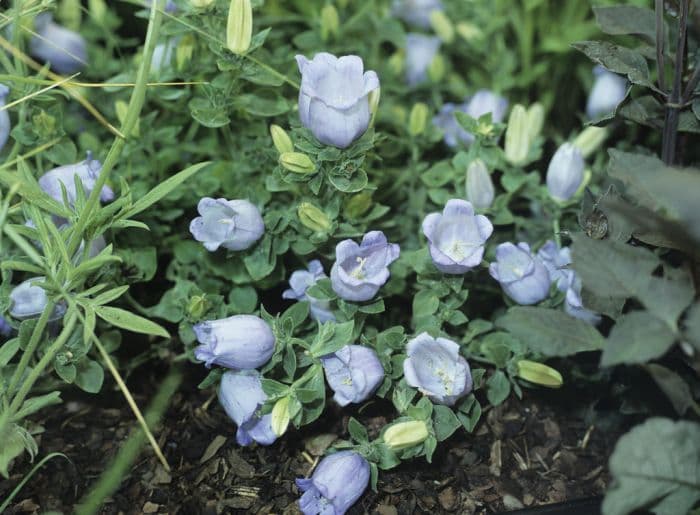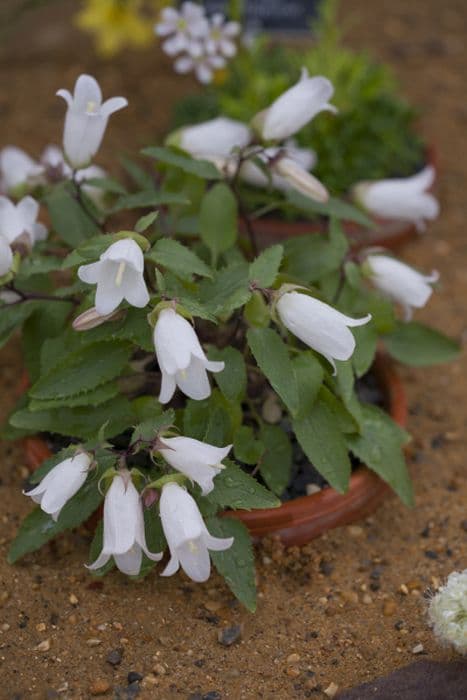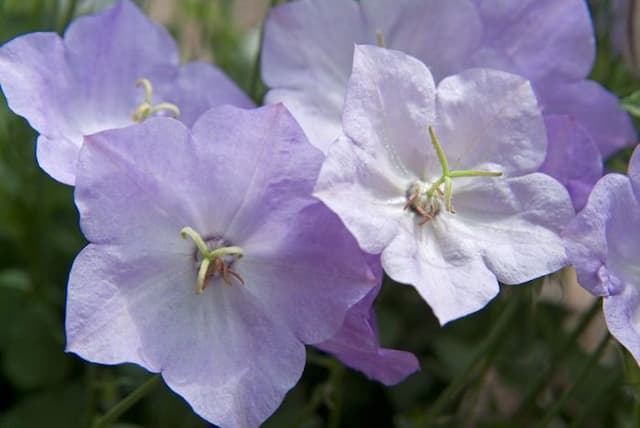Grecian Bellflower Campanula incurva

ABOUT
Campanula incurva, commonly known as the incurved bellflower, is a charming perennial plant known for its showy flowers and attractive foliage. The blooms of this plant are its most striking feature, presenting a profusion of bell-shaped flowers. These blossoms have a captivating curve to them, with the edges often recurved back upon themselves, creating an impression of an elegant, flaring trumpet. The color of the flowers tends to be a striking shade of blue, although sometimes they can be found in hues of white or pale purple. The foliage of the incurved bellflower is also quite appealing. The leaves usually grow in a basal rosette, emanating outward from the base of the plant. They typically have a soft, hairy texture, lending a lush, tactile quality to the touch. The leaves are often deeply green, which contrasts beautifully with the light-colored flowers. As the leaves extend from the rosette, they may vary in shape, with some presenting a more oval contour, while others may appear lance-shaped with a slightly serrated edge. Overall, the incurved bellflower makes an attractive addition to gardens and landscapes, adding a touch of whimsical beauty with its distinctive curved flowers and verdant foliage.
About this plant
 Names
NamesSynonyms
Cup-and-Saucer, Grecian Bellflower
Common names
Campanula saxatilis, Campanula hawkinsiana
 Toxicity
ToxicityTo humans
The plant commonly known as Cup-and-Saucer is not generally considered to be toxic to humans. There are no significant reports of Cup-and-Saucer causing poisoning when touched or ingested; however, as with any plant, it's possible for individuals to have allergic reactions or sensitivities. It is always advisable to avoid eating plants that are not known to be safe for consumption and to supervise children and pets around plants.
To pets
Cup-and-Saucer is also not known to be toxic to pets. This means that if your pet were to ingest parts of the Cup-and-Saucer plant, they would be unlikely to experience poisoning. Nevertheless, it's always better to prevent pets from eating plants since they could cause digestive upset or an allergic reaction in sensitive animals. It is advisable to monitor your pets and discourage them from chewing on houseplants and garden plants.
 Characteristics
CharacteristicsLife cycle
Biennials
Foliage type
Deciduous
Color of leaves
Green
Flower color
Blue
Height
1 foot (0.3 meters)
Spread
1 foot (0.3 meters)
Plant type
Herb
Hardiness zones
8
Native area
Greece
Benefits
 General Benefits
General Benefits- Ornamental Appeal: Campanula incurva, commonly known as Harebell, features attractive bell-shaped flowers that enhance garden aesthetics.
- Attracts Pollinators: Harebell’s flowers attract bees, butterflies, and other beneficial insects, supporting local ecosystems.
- Drought Tolerance: Harebell is known for its ability to withstand periods of low water availability, making it suitable for xeriscaping.
- Low Maintenance: Due to its hardiness, Harebell typically requires minimal care once established, making it a convenient choice for gardeners of all levels.
- Cold Hardy: Harebell can survive in colder climates, making it a versatile addition to gardens in various temperature zones.
- Ground Cover: With its spreading habit, Harebell can function as ground cover, reducing weed growth and soil erosion.
- Garden Design Versatility: Harebell can be used in various garden designs including rock gardens, border fronts, and alpine gardens.
- Long Blooming Period: Harebell often enjoys a lengthy blooming season, providing color and interest in the garden for an extended period.
 Medical Properties
Medical PropertiesThis plant is not used for medical purposes.
 Air-purifying Qualities
Air-purifying QualitiesThis plant is not specifically known for air purifying qualities.
 Other Uses
Other Uses- Edible Decoration: The flowers of Campanula can be used as edible garnishes for salads and desserts, adding a splash of color with their blue to violet hues.
- Fairy Gardens: With its charming bell-shaped flowers, Campanula is often integrated into fairy gardens for a whimsical touch.
- Bee Attractant: Campanula serves as an excellent source of nectar for bees, making it an ideal choice for those looking to support pollinator populations.
- Drying for Crafts: The flowers can be dried and used in dried flower arrangements or to create lasting floral displays.
- Photography Prop: Due to their photogenic nature, the flowers of Campanula are popular subjects for photographers and artists.
- Living Mulch: When planted densely, Campanula can act as a living mulch, helping to retain soil moisture and suppress weeds.
- Symbolic Gift: The bell-shaped flowers are sometimes given as a symbol of constancy and gratitude in bouquets and potted gifts.
- Alternative Lawn: Some species of Campanula can be used to create a flowering alternative to traditional grass lawns in suitable climates.
- Culinary Experimentation: The leaves of some Campanula species are edible and can be experimented with in culinary dishes, although they are not common as food items.
- Educational Use: Campanula can be included in educational botanical gardens to teach about plant biology and the diversity within the Campanulaceae family.
Interesting Facts
 Feng Shui
Feng ShuiThe plant Campanula is not used in Feng Shui practice.
 Zodiac Sign Compitability
Zodiac Sign CompitabilityThe plant Campanula is not used in astrology practice.
 Plant Symbolism
Plant Symbolism- Gratitude: The bell-shaped flowers of the Campanula incurva, commonly known as the 'bellflower,' are often associated with gratitude, possibly due to their delicate and poised appearance that seems to nod in appreciation.
- Constancy and Perseverance: With its ability to grow in challenging conditions and return year after year, the bellflower symbolizes steadfastness and the perseverance to overcome obstacles.
- Unwavering Love: The bellflower, in particular, may represent unwavering love, reflecting the plant's enduring and consistent blooming patterns.
- Humility: The bell shape of the Campanula incurva, with its head bowed down, can be seen as a symbol of humility, suggesting a quiet elegance and modesty.
 Water
WaterThe Campanula incurva, commonly known as the Grecian Bellflower, should be watered regularly to maintain evenly moist soil, especially during spring and summer when the plant is actively growing. Allow the top inch of the soil to dry out slightly between waterings to prevent root rot. Typically watering once a week with 16-24 ounces of water, depending on the size of the pot and the environment, is sufficient. During the dormant period in fall and winter, you should reduce the frequency, watering only when the soil feels dry to the touch. Ensure proper drainage to avoid waterlogging.
 Light
LightThe Grecian Bellflower thrives in bright, indirect light. It prefers a location that gets morning sunlight and partial shade in the afternoon to protect it from the intense sun. A spot near an east-facing window or a shaded south or west-facing window is ideal for this plant. Avoid placing it in deep shade or full, harsh sunlight, as both extremes can impede its growth.
 Temperature
TemperatureThe Grecian Bellflower does best in temperatures ranging from 60 to 75 degrees Fahrenheit. It can withstand a minimum temperature of around 50 degrees Fahrenheit but should be protected from frost and freezing conditions. Maintaining the temperature within this range will encourage healthy growth and flowering.
 Pruning
PruningPrune the Grecian Bellflower to remove spent flowers and encourage a second bloom. Pruning is also beneficial to shape the plant and promote more compact, bushy growth. The best time to prune is after the first flush of flowers has faded, usually in mid to late summer. Light pruning every few weeks can be done to maintain the desired form and health of the plant.
 Cleaning
CleaningAs needed
 Soil
SoilThe best soil mix for Grecian bellflower, the common name for Campanula incurva, should be well-draining and fertile, with added compost or peat moss to retain some moisture. It prefers a soil pH that ranges from slightly acidic to neutral, around 6.0 to 7.5. You can create an ideal mix using equal parts garden soil, compost, and perlite or sand for improved drainage.
 Repotting
RepottingGrecian bellflower should be repotted every couple of years or when it outgrows its current pot. It's best done in spring or early summer, just before the beginning of the growing season. Ensure you choose a new pot that's slightly larger than the old one to give the roots some room to expand.
 Humidity & Misting
Humidity & MistingGrecian bellflower thrives best in moderate humidity levels. It does not require high humidity and can tolerate the humidity levels found in most homes. However, if the air is very dry, occasional misting can be beneficial.
 Suitable locations
Suitable locationsIndoor
Ensure bright indirect light, moderate watering, and well-draining soil.
Outdoor
Plant in partial shade, shelter from strong winds, and ensure soil drains well.
Hardiness zone
5-9 USDA
 Life cycle
Life cycleThe life cycle of Campanula incurva, commonly known as the incurved bellflower, begins with seed germination, typically in spring, under appropriate light and temperature conditions. The seeds sprout, establishing a rosette of basal leaves as the seedling grows. With favorable conditions, the plant enters a vegetative stage, developing a stout stem and foliage. During the flowering stage, usually in late spring to early summer, Campanula incurva produces clusters of large, showy, bell-shaped blue flowers at the stem tips. After pollination by insects attracted by the flowers, the plant sets seed, which matures in capsule-like structures that eventually release seeds for the next generation. The plant may die after seeding in biennial or perennial lifecycles, depending on the environmental conditions and genetic traits.
 Propogation
PropogationPropogation time
Spring to summer
The most popular method of propagation for Campanula incurva, commonly known as the cup-and-saucer plant, is through seed sowing. The optimal time for sowing seeds of the cup-and-saucer plant is in late winter to early spring. The seeds should be scattered on the surface of a well-draining soil mix, preferably in a seed tray. They require light to germinate, so they should not be covered with soil but can be gently pressed into the substrate. The tray should be kept at a temperature of around 65-70 degrees Fahrenheit (18-21 degrees Celsius), and the soil should be kept moist but not waterlogged. Germination will take place in a couple of weeks, after which the seedlings can be transplanted into individual pots once they are large enough to handle.









